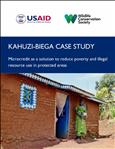Title
Kahuzi-Biega Case Study: Microcredit as a solution to reduce poverty and illegal resource use in protected areas
Author(s)
Detoeuf, D.; Twendilonge, A.; Kavuba, F.; Cito, R.; Radford, N.; Leal, M.
Published
2019
Abstract
In 2010, WCS launched a microcredit project in the Tshivanga sector of Kahuzi-Biega National
Park (KBNP) to reduce the illegal use of natural resources and protect the Grauer's gorilla
population and their habitat. In total, 10 villages participated in the project, and 1,236 people benefited from approximately $150,000 USD of loans between 2010 and 2018. Beneficiaries included men, women, indigenous people and wherever possible, former hunters/poachers,
charcoal producers, and bamboo collectors. WCS was the main provider of the seed funding
thanks to the CARPE grant, but Fauna and Flora International and the United Nations
Environment Program also contributed financially. The microcredit was directly managed by community groups, with supervision from WCS and ICCN.
Keywords
microfinance; microcredit; poverty; Kahuzi-Biega; livelihoods
Full Citation
D. Detoeuf, A. Twendilonge, F. Kavuba, R. Cito, N. Radford, M. Leal 2019. K ahuzi-Biega case study: Microfinance as a solution to reduce poverty and illegal resource use in protected areas. WCS, New York, USA.
Access Full Text

Back
DMX3856300000